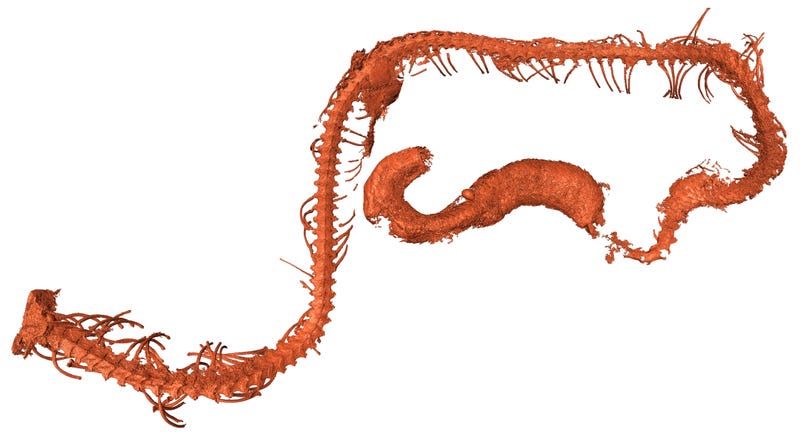A mid-Cretaceous embryonic-to-neonate snake in amber from Myanmar
Lida Xing1,2, Michael W. Caldwell3,*, Rui Chen4, Randall L. Nydam5, Alessandro Palci6,7, Tiago R. Simões3, Ryan C. McKellar8,9, Michael S. Y. Lee6,7, Ye Liu4,10, Hongliang Shi11, Kuan Wang10 and Ming Bai4
1State Key Laboratory of Biogeology and Environmental Geology, China University of Geosciences, Beijing 100083, China.
2School of the Earth Sciences and Resources, China University of Geosciences, Beijing 100083, China.
3Department of Biological Sciences, University of Alberta, Edmonton, Alberta T6G 2E9, Canada.
4Key Laboratory of Zoological Systematics and Evolution, Institute of Zoology, Chinese Academy of Sciences, Beijing 100101, China.
5Department of Anatomy, Midwestern University, Glendale, AZ 85308, USA.
6South Australian Museum, North Terrace, Adelaide, South Australia 5000, Australia.
7College of Science and Engineering, Flinders University, Adelaide, South Australia, Australia.
8Royal Saskatchewan Museum, Regina, Saskatchewan S4P 4W7, Canada.
9Biology Department, University of Regina, Regina, Saskatchewan S4S 0A2, Canada.
10Paleo-diary Museum of Natural History, Beijing 100097, China.
11Beijing Forestry University, Beijing 100083, China.
↵*Corresponding author. Email: mw.caldwell@ualberta.ca
Science Advances 18 Jul 2018:
Vol. 4, no. 7, eaat5042

Abstract
We present the first known fossilized snake embryo/neonate preserved in early Late Cretaceous (Early Cenomanian) amber from Myanmar, which at the time, was an island arc including terranes from Austral Gondwana. This unique and very tiny snake fossil is an articulated postcranial skeleton, which includes posterior precloacal, cloacal, and caudal vertebrae, and details of squamation and body shape; a second specimen preserves a fragment of shed skin interpreted as a snake. Important details of skeletal ontogeny, including the stage at which snake zygosphene-zygantral joints began to form along with the neural arch lamina, are preserved. The vertebrae show similarities to those of fossil Gondwanan snakes, suggesting a dispersal route of Gondwanan faunas to Laurasia. Finally, the new species is the first Mesozoic snake to be found in a forested environment, indicating greater ecological diversity among early snakes than previously thought.
Copyright © 2018 The Authors, some rights reserved; exclusive licensee American Association for the Advancement of Science. No claim to original U.S. Government Works. Distributed under a Creative Commons Attribution NonCommercial License 4.0 (CC BY-NC).
This is an open-access article distributed under the terms of the Creative Commons Attribution-NonCommercial license, which permits use, distribution, and reproduction in any medium, so long as the resultant use is not for commercial advantage and provided the original work is properly cited.
FREE PDF GRATIS: Science Advances Sup. Info.


